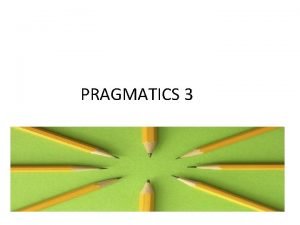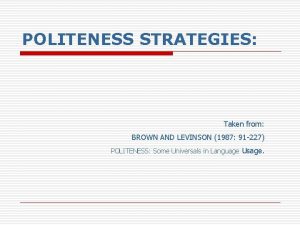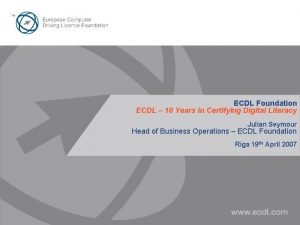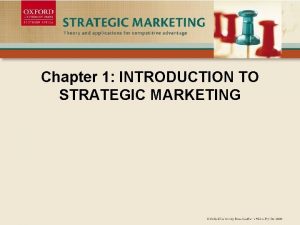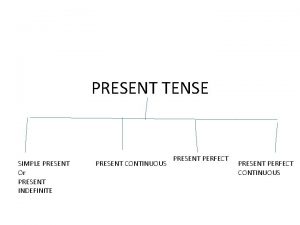strategic management INTRODUCTION Management at present face many



















- Slides: 19

strategic management

INTRODUCTION Management at present face many challenges in running their business. The challenges are both from internal and external environment. There are conflicting claims from employees , managers , owners etc. The economic conditions , social changes , political parties all influence decision making process of an organization. In order to face all such situations , executives have to design strategic management processes and help the firm in achieving pre – determined business goals. Strategic management helps in anticipating environment changes and preparing the business to meet unexpected situations.

STRATEGIC MANAGEMENT � Strategic management involves those decisions and actions resulting in formulation and implementation of strategies designed to achieve the objectives of an organization. � It is a stream of decisions and actions which leads to the development of an effective strategy to help achieve corporate objectives. � Strategic management is concerned with planning and decision making. It is more concerned with general management rather than functional management. � The effect in strategic management is to see that management is able to face changing environment effectively for the benefit of the business

DEFINITIONS According to A. Sharplin , “ Strategic management is the formation and implementation of plans and carrying out of activities relating to the matters which are of vital , pervasive , or continuing importance to the total organization. ” According to Lawrence & William , “ Strategic management is a stream of decisions and actions which leads to the development of an effective strategy or strategies to help achieve corporate objectives. The strategic management process is the way in which strategists determine objectives and make strategic decisions.

DIFFERENCE BETWEEN STRATEGIC MANAGEMENT � � � Strategic management is mainly concerned with top management. Strategic management formulates policies for the whole organization. The policies framed by strategic management are generally on long term basis. Strategic management can take strategic decisions such as adding product , expansion program etc. Important decisions are taken so there is a need of proper analysis of situation and foresight in planning strategies. OPERATIONAL MANAGEMENT � � � Operational management is concerned with functional management. Operative management is done by functional or departmental heads. The policies framed by operative management are to face current situations. These types of decisions are not taken by operative management. Operative management deals with normal situations and hence less tension at this level.

DIMENSIONS OF STRATEGIC DECISIONS Strategic management process involves decision – making at every stage whether formulation or implementation of strategy. Strategic decisions have the following dimensions : � Top level management. � Allocation of large resources. � Long term impact. � Future oriented. � Multifunctional consequences. � Impact of external environment.

Approaches to strategic management Formal structured approach Entrepreneurial approach Incremental approach Intuitive anticipatory approach Adaptive approach

FORMAL STRUCTURED APPROACH � It is one method of planning the things in a formal way. The thrust of every management is to achieve the organizational goals. It will necessitate clear cut planning & proper implementation. � Strategic planning is assigned to experienced persons who have full knowledge of various aspects needed for it. � The formal approach of strategic management follows three stages : ü Diagnostic ü Direction ü Implementation.

ENTREPRENEURIAL APPROACH Every entrepreneur will aim to earn as much profits as possible. For this purpose he will try to exploit every possible opportunity available. The entrepreneur tries to make assumptions for the future and then take strategic decisions in the best interest of the company. This is a self interest and self oriented approach. This approach is commonly adopted by individual entrepreneur or small scale concerns , it may not be adopted by corporate sector.

INTUITIVE ANTICIPATORY APPROACH � Intuitive approach is individual based. � The promoter of a business anticipates future opportunities and possibilities and take decisions on such forecasts. � It is the promoters experience, judgment, and anticipations which are the basis of strategic planning. � This approach is feasible only at the initial periods of the company than in its future plans of development at a later stage.

INCREMENTAL APPROACH This approach has a limited role for strategic decision making. Mostly decisions are based on consensus and whatever strategic decisions are taken these are of remedial nature. This approach is popularly known as Muddling Through Approach as it involves in making few alternatives at a time. This approach is generally adopted by public companies which are supposed to work under social and political pressures.

ADAPTIVE APPROACH �The strategies adopted by a company should be flexible. These should be adjustable as per the changing business environment. �Under uncertain environment , adaptive approach is most suitable. �In this approach strategic decisions are taken on the basis of changing environment and its likely impact at a given time. �When the situation is uncertain , fluid and changing then contingency planning should be used instead of sticking to long term plans.

CRITICAL AREAS IN STRATEGIC MANAGEMENT 1. 2. 3. 4. 5. 6. 7. 8. 9. John A. Pierce & Richard B. Robinson has given 9 critical areas which involves attention in strategic management. These are as follows : Determining the mission of company. Developing a company profile. Assessment of company’s external environment. Analysis of possible options. Identifying the desired options. Choice of long term objectives. Development of annual objectives. Implementing strategic choice decisions. Review and evaluation of strategic process.

NEED FOR STRATEGIC MANAGEMENT Strategic management is needed to improve the overall performance of a firm. It is needed to face the challenges under which the present business is run. Strategic management is essential for the following reasons : �To face changing environment. �To motivate employees. �To improve decision making.

ADVANTAGES OF STRATEGIC MANAGEMENT The advantages of strategic management are as follows : � Participative decision making. � Better employee motivation. � Better communication. � Resistance to change reduced. � Increased profitability.

COMPONENTS OF STRATEGIC MANAGEMENT Businesses use different processes to formulate and direct their strategic management activities. Some big undertakings involves a sophisticated planning process which small concerns may have less formal planners. Every firm has to follow a system which leads to strategic planning. A commonly used process for strategic management is described as follows :

� � � � � Company mission. Company profiles. External environment. Strategic Analysis & Choice. Long term objectives. Grand Strategy. Functional Strategies. Policies. Control & Evaluation.

Assessment of present strategy Selecting alternative and evaluation Process of strategic management Formulating a strategy Identification of the problem

ROLE OF CEO � � � The role of CEO is very important in formulating , implementing and evaluation of strategies. CEO is the top man , next to the board of Directors. He is designated differently in different companies. The CEO is identified with & ultimately accountable for a strategy’s success. In big concerns CEO spends 80 % of his time in developing & guiding strategies. His role is both symbolic and sustentative in strategy implementation. The CEO is a symbol of new strategy. His actions and perceived seriousness about the implementation of a strategy will influence the behavior of subordinate managers. He is an important source of clarification & guidance during the implementation of strategy. A successful implementation of a strategy is directly related to the unique characteristics, orientation & actions of the CEO.
 Strategic competitiveness
Strategic competitiveness Strategic analysis and choice in strategic management
Strategic analysis and choice in strategic management High considerateness style
High considerateness style Brown and levinson
Brown and levinson Hospice face to face template
Hospice face to face template Site:slidetodoc.com
Site:slidetodoc.com Face to face interview pros and cons
Face to face interview pros and cons Brown and levinson face
Brown and levinson face I have a flat face
I have a flat face Example of a simile in romeo and juliet
Example of a simile in romeo and juliet Cis face and trans face
Cis face and trans face Myron b thompson academy
Myron b thompson academy Ecdl.com
Ecdl.com Introduction to strategic marketing management
Introduction to strategic marketing management Introduction of strategic management
Introduction of strategic management Strategic fit vs strategic intent
Strategic fit vs strategic intent Strategic complements and substitutes
Strategic complements and substitutes I write a letter now past continuous tense
I write a letter now past continuous tense Present perfect conjugation
Present perfect conjugation Present perfect continuous cand se foloseste
Present perfect continuous cand se foloseste


